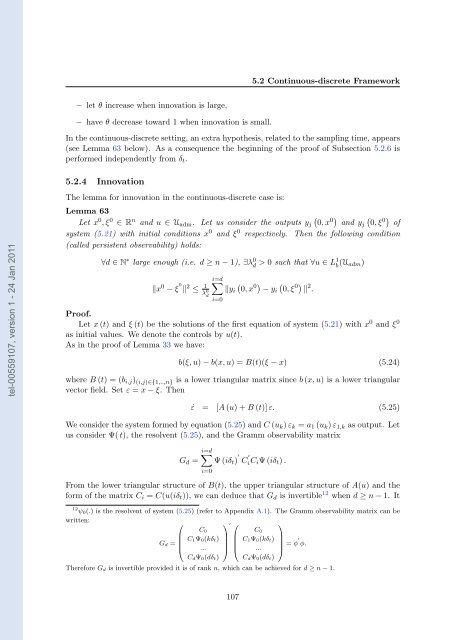Adaptative high-gain extended Kalman filter and applications
Adaptative high-gain extended Kalman filter and applications
Adaptative high-gain extended Kalman filter and applications
Create successful ePaper yourself
Turn your PDF publications into a flip-book with our unique Google optimized e-Paper software.
tel-00559107, version 1 - 24 Jan 2011<br />
− let θ increase when innovation is large,<br />
− have θ decrease toward 1 when innovation is small.<br />
5.2 Continuous-discrete Framework<br />
In the continuous-discrete setting, an extra hypothesis, related to the sampling time, appears<br />
(see Lemma 63 below). As a consequence the beginning of the proof of Subsection 5.2.6 is<br />
performed independently from δt.<br />
5.2.4 Innovation<br />
The lemma for innovation in the continuous-discrete case is:<br />
Lemma 63<br />
Let x0 , ξ0 ∈ Rn �<br />
<strong>and</strong> u ∈ Uadm. Let us consider the outputs yj 0,x0 � �<br />
<strong>and</strong> yj 0, ξ0 � of<br />
system (5.21) with initial conditions x0 <strong>and</strong> ξ0 respectively. Then the following condition<br />
(called persistent observability) holds:<br />
∀d ∈ N ∗ large enough (i.e. d ≥ n − 1), ∃λ 0 d > 0 such that ∀u ∈ L1 b (Uadm)<br />
�<br />
�x0 − ξ 0<br />
�2 ≤ 1<br />
λ0 i=d<br />
d<br />
i=0<br />
� 0<br />
�yi 0,x � � 0<br />
− yi 0, ξ � � 2 .<br />
Proof.<br />
Let x (t) <strong>and</strong> ξ (t) be the solutions of the first equation of system (5.21) with x 0 <strong>and</strong> ξ 0<br />
as initial values. We denote the controls by u(t).<br />
As in the proof of Lemma 33 we have:<br />
b(ξ,u) − b(x, u) =B(t)(ξ − x) (5.24)<br />
where B (t) = (bi,j) (i,j)∈{1,..,n} is a lower triangular matrix since b (x, u) is a lower triangular<br />
vector field. Set ε = x − ξ. Then<br />
˙ε = [A (u)+B (t)] ε. (5.25)<br />
We consider the system formed by equation (5.25) <strong>and</strong> C (uk) εk = a1 (uk) ε1,k as output. Let<br />
us consider Ψ( t), the resolvent (5.25), <strong>and</strong> the Gramm observability matrix<br />
�i=d<br />
Gd = Ψ (iδt) ′<br />
i=0<br />
C ′<br />
iCiΨ (iδt) .<br />
From the lower triangular structure of B(t), the upper triangular structure of A(u) <strong>and</strong> the<br />
form of the matrix Ci = C(u(iδt)), we can deduce that Gd is invertible 12 when d ≥ n − 1. It<br />
12 ψ0(.) is the resolvent of system (5.25) (refer to Appendix A.1). The Gramm observability matrix can be<br />
written:<br />
⎛<br />
⎜<br />
Gd = ⎜<br />
⎝<br />
C0<br />
C1Ψ0(kδt)<br />
...<br />
CdΨ0(dδt)<br />
⎞′<br />
⎛<br />
⎟ ⎜<br />
⎟ ⎜<br />
⎟ ⎜<br />
⎠ ⎝<br />
C0<br />
C1Ψ0(kδt)<br />
...<br />
CdΨ0(dδt)<br />
⎞<br />
⎟<br />
⎠<br />
= φ′ φ.<br />
Therefore Gd is invertible provided it is of rank n, which can be achieved for d ≥ n − 1.<br />
107

















